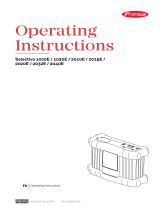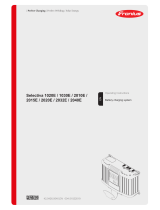
Contents
3/30 4156 EN
Index
1
General ...........................................................................................................................4
1.1
Purpose of Operating Instructions...........................................................................................4
2
Safety..............................................................................................................................4
2.1
General ......................................................................................................................................4
2.2
Decal and Symbol Notices........................................................................................................4
2.3
Personnel Qualification.............................................................................................................5
2.3.1
Commercial Use................................................................................................................5
2.4
Correct use and application......................................................................................................5
2.5
Assembly and Installation Safety Instructions........................................................................6
2.6
Operating Safety Instructions...................................................................................................7
2.7
Troubleshooting and Repairs Safety Instructions...................................................................7
3
Product Specifications ..................................................................................................7
3.1
Product Functional Description................................................................................................7
3.2
Model Description.....................................................................................................................8
3.3
Accessory Functional Description...........................................................................................8
3.3.1
Charger.............................................................................................................................8
3.4
Residual Risk.............................................................................................................................8
3.5
Protective Mechanisms.............................................................................................................9
3.6
Charger Labelling and Decals.................................................................................................10
4
Transport, Handling and Storage................................................................................10
5
Assembly / Installation / Commissioning...................................................................10
5.1
Delivery scope.........................................................................................................................10
5.2
Site Requirements...................................................................................................................11
5.3
Mains Connection and Mains Fuses.......................................................................................11
5.4
Assembly and Installation.......................................................................................................12
5.5
Commissioning the charger for the first time and operational testing.................................12
6
Operation......................................................................................................................12
6.1
Operating and Display Function.............................................................................................13
6.1.1
Charge Status Light.........................................................................................................14
6.1.2
Soft keys.........................................................................................................................15
6.1.3
Graphic display and menu structure.................................................................................16
6.1.4
Adjustable parameters.....................................................................................................17
6.1.5
Function – Battery Maintenance.......................................................................................17
6.1.6
Function – Measured values............................................................................................18
6.1.7
Graphic Display Information.............................................................................................18
6.1.8
Parameters – Consumption data......................................................................................18
6.1.9
Parameters - Statistics.....................................................................................................19
6.2
Charger Mains Connection.....................................................................................................19
6.3
Battery Connection.................................................................................................................19
6.4
Charging automatic start........................................................................................................20
6.5
Interrupting a charge...............................................................................................................21
6.6
Charging automatic end..........................................................................................................21
6.7
Readings..................................................................................................................................22
6.8
Status messages.....................................................................................................................23
6.9
Faults and Error Messages.....................................................................................................24
6.10
Switching off the charger........................................................................................................25
7
Maintenance.................................................................................................................25
7.1
Cleaning, Inspection and Maintenance..................................................................................25
7.2
Changing the charging program.............................................................................................26
7.3
Spare parts..............................................................................................................................26
8
Disposal........................................................................................................................26
9
Appendix.......................................................................................................................27
9.1
Dimension and Projection Drawings (not to scale) ...............................................................27
9.2
Specifications..........................................................................................................................28
9.3
Model table..............................................................................................................................28
9.4
Charging programs.................................................................................................................29
9.5
Spare parts catalog.................................................................................................................30























